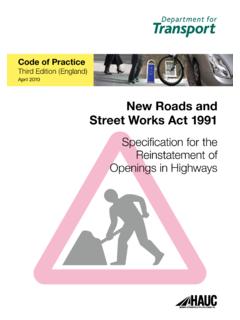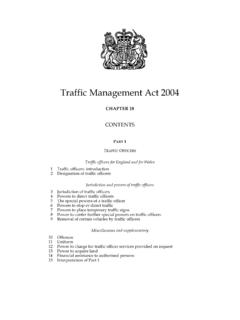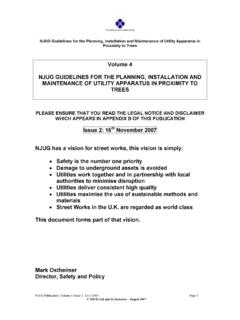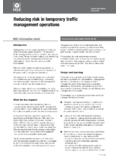Transcription of New Roads and Street Works Act 1991: Code of …
1 Code of PracticeFourth EditionRevised October 2012 New Roads and Street Works Act 1991 Code of Practice for the Co-ordination of Street Works and Works for road Purposes and Related MattersNew Roads and Street Works Act 1991 Code of Practice for the Co-ordination of Street Works and Works for road Purposes and Related Matters New Roads and Street Works Act 1991 Code of Practice for the Co-ordination of Street Works and Works for road Purposes and Related MattersApproved by the Secretary of State for Transport under sections 56, 56A, 59, 60 and 74 of the ActOctober 2012 Department for TransportLondon: The Stationery OfficePublished by TSO (The Stationery Office) and available , Telephone, Fax & E-mailTSOPO Box 29, Norwich, NR3 1 GNTelephone orders/General enquiries: 0870 600 5522 Fax orders: 0870 600 5533E-mail: 0870 240 3701 TSO@Blackwell and other Accredited AgentsDepartment for TransportGreat Minster House33 Horseferry RoadLondon SW1P 4 DRTelephone 0300 330 3000 Web site Crown copyright 2009 and 2012, except where otherwise in the typographical arrangement rests with the may re-use this information (not including logos or third-party material) free of charge in any format or medium, under the terms of the Open Government Licence.
2 To view this licence, visit or write to the Information Policy Team, The National Archives, Kew, London TW9 4DU, or e-mail: we have identified any third-party copyright information you will need to obtain permission from the copyright holders 978 0 11 553251 1 Printed in Great Britain on material containing 75% post-consumer waste and 25% ECF C4 10/12 ContentsFOREWORD 7 CHAPTER 1 9 Introduction Legislative framework 10 Other statutory obligations 11 CHAPTER 2 14Co-ordination in practice Introduction Information Analysis Consideration Co-operation Forward planning Collaborative working Reinstatements Phasing of Works Interrupted Works Performance Management Measures (PMMs)
3 23 CHAPTER 3 24 The Register Introduction Register keepers Local and central registers Form of registers Content of registers Access to registered information 27 CHAPTER 4 29 The Street Gazetteer and additional Street data Introduction The Street Gazetteer Additional Street data 303 Code of Practice for the Co-ordination of Street Works for road Purposes and Related Matters4 CHAPTER 5 32 Streets Subject to Special Controls Introduction Protected Streets Streets with Special Engineering difficulties (SED) Traffic sensitive streets Procedure for making designations Procedure for withdrawing designations Other features of the Street (structures, environmental areas etc)
4 39 CHAPTER 6 41 Restrictions introduction Substantial Works definitions Creating a restriction Duration of restrictions Works during a restriction Policy guidance Dispute resolution 46 CHAPTER 7 47 Works classification Works promoters Street Works licences Registerable Works Street authority Works for road purposes Categorisation of Works Remedial Works 54 CHAPTER 8 56 Notice requirements and validity Introduction Notice types General rules applying to all notices Notice validity 66 CHAPTER 9 70 Directions Introduction Section 56 directions Section 56A directions Revocation of directions Street authority responses Avoidance of unnecessary delay or obstruction (section 66) 735 ContentsCHAPTER 10 74 Charging Schemes 10.
5 1 Section 74A charges for occupation of the highway Section 74 charges for unreasonably prolonged occupation of the highway Exempt Works Prescribed period Reasonable period Duration of Works Section 74 notice types Informal warning Charging regime Remedial Works Invoicing/paying the charge 79 CHAPTER 11 81 Fixed Penalty Notices Introduction Fixed penalty offences under part 3 of NRSWA Time periods Guidance for the Street authority Guidance for undertakers Representations Application of money by Street authorities 91 CHAPTER 12 92 Related Matters road closures and traffic restrictions Maintenance of undertakers apparatus Working near rail tracks and tramways Vehicle parking at Street and road Works Storing materials Apparatus belonging to others Assessing the impact of Works Environmental issues 99 CHAPTER 13 10 0 Dispute Resolution Introduction 10 Dispute review Adjudication 10 Arbitration 10 16 APPENDICES 10 2 APPENDIX A 10 3 Glossary APPENDIX B 111 Transitional arrangements APPENDIX C 116 Works at or near level crossings Annex A 126 Annex B 127 APPENDIX D 128 Works near highway structures Annex 1 134 Annex 2 146 APPENDIX E 148Co-ordination schedules APPENDIX F 149 Central registers APPENDIX G 151 Derivation of
6 Disruption effect score APPENDIX H 154 Fixee Penalty Notice forms APPENDIX I 162 Changes since July 2007 7 FOREWORDThe New Roads and Street Works Act 1991 (NRSWA), supported by relevant Regulations and Codes of Practice, provides a legislative framework for Street Works by undertakers (including utility companies) and Works for road purposes to the extent that these must be co-ordinated by Street aim is to balance the statutory rights of highway authorities and undertakers to carry out Works with the right of road users to expect the minimum disruption from Secretary of State for Transport has approved this code under the powers to approve or issue codes of practice in the following sections of NRSWA: Section 56(4) the power of authorities to give directions as to the timing of Street Works Section 56A(8) the power of authorities to give directions as to the placing of apparatus Section 59(3) the duty of Street authorities to co-ordinate Works Section 60(2) the duty of undertakers to co-operate with Street authorities and with other Code reflects various changes made to the provisions of NRSWA under the Traffic Management Act 2004 (TMA).
7 The TMA tightens the regulatory framework within which undertakers dig up Roads , giving authorities more power to co-ordinate, control and direct Works effectively with the aim of minimising Code also incorporates the requirements set out in the following regulations: The Street Works (Registers, Notices, Directions and Designations) (England) Regulations 2007,SI 2007, No. 1951; The Street Works (Fixed Penalty) (England) Regulations 2007, SI 2007, No. 1952; The Street Works (Charges for the Unreasonably Prolonged Occupation of the Highway) (England) Regulations 2009, SI 2009, No. 303 (as amended by SI 2012 No. 2272); The Street Works Register (Registration Fees) Regulation 1999, SI 1999, No. 1048; and The Street Works (Charges for Occupation of the Highway) (England) Regulations 2012, SI 2012 No.
8 Guidance is given on undertakers and authorities responsibilities with regard to Street or highway Works . The relevant sections of NRSWA are listed on the inside front Code was prepared by several working parties comprising representatives of the Department for Transport, the National Joint Utilities Group and local highway authorities and was the subject of extensive consultation with relevant Works are a devolved matter in Scotland and Wales. This 4th edition of the Code has been approved by the Secretary of State for Transport for use in England only. It replaces the 3rd edition published in August 2009 and comes into operation on 1 October 1 IntroductionThe efficient co-ordination of Street Works is one of the most important aspects of Street Works legislation, benefiting Street authorities, undertakers and road users alike.
9 The New Roads and Street Works Act 1991 (NRSWA) sets out the objectives of the co-ordination function: to ensure safety; to minimise inconvenience to people using a Street , including a specific reference to people with a disability; and to protect the structure of the Street and the apparatus in Code of Practice is intended to help Street authorities carry out their duty to co-ordinate Works in the highway, under section 59 of NRSWA, and undertakers to fulfil their duty to co-operate in this process, under section 60 of legislative and regulatory provisions explained in this Code may be best viewed as three pillars of co-ordination: The Notice System. Notices provide valuable information to aid the co-ordination process, while notice periods provide time for appropriate steps to be taken.
10 See chapters 3-4, 7-8 and 11. Streets subject to special controls. Designation procedures allow for attention to be focussed on particularly sensitive streets. Traffic-sensitive streets are especially important in this context. See chapter 5. The Co-ordination Tools. The legislation provides tools to help the co-ordination process, including powers to restrict further Works following substantial Street or road Works and to direct the timing, date and location of Street Works . See chapters 6 and authorities and undertakers must adhere to three key principles: the need to balance the potentially conflicting interests of road users and undertakers customers; the importance of co-operation and regular communication between Street authorities and undertakers; and an acknowledgement that Works programmes and practices may have to be adjusted to meet the statutory objectives of the co-ordination Code explains how these principles can be made to work in practice.
















